SKODA CITIGO 2014 1.G Owners Manual
Manufacturer: SKODA, Model Year: 2014, Model line: CITIGO, Model: SKODA CITIGO 2014 1.GPages: 164, PDF Size: 12.08 MB
Page 91 of 164
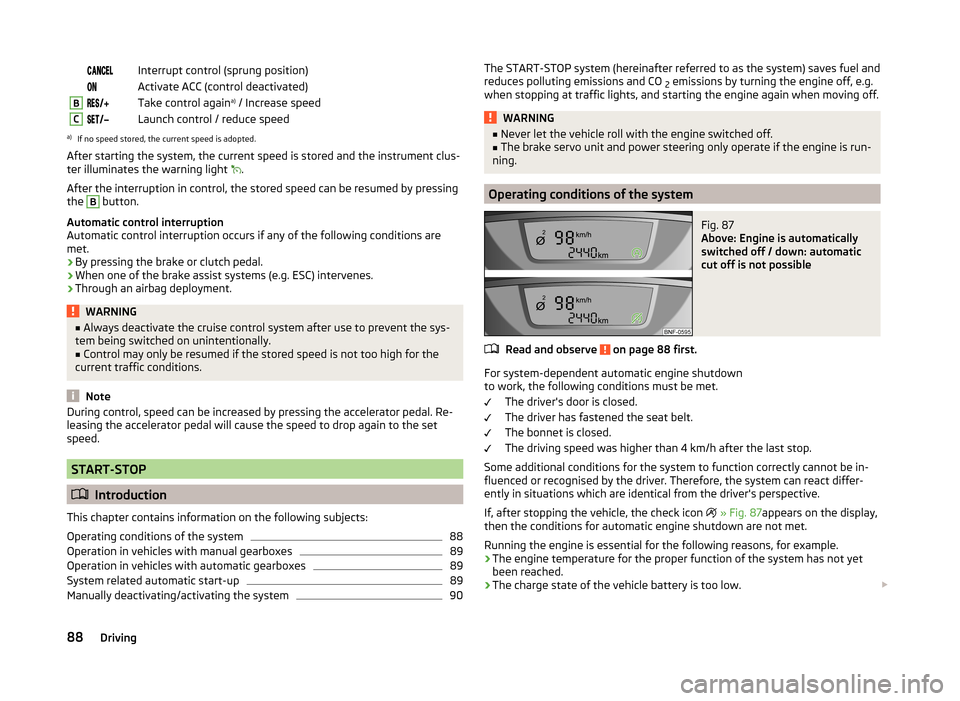
’üā’üü’üÄ’üā’üģ’üīInterrupt control (sprung position) ’üÅ’üÄActivate ACC (control deactivated)B’üÆ’üģ’üō’āł’āēTake control againa)
/ Increase speedC’üō’üģ’üö’āł’āŖLaunch control / reduce speeda)
If no speed stored, the current speed is adopted.
After starting the system, the current speed is stored and the instrument clus-
ter illuminates the warning light ’üØ
.
After the interruption in control, the stored speed can be resumed by pressing
the
B
button.
Automatic control interruption
Automatic control interruption occurs if any of the following conditions are
met.
ŌĆ║ By pressing the brake or clutch pedal.
ŌĆ║ When one of the brake assist systems (e.g. ESC) intervenes.
ŌĆ║ Through an airbag deployment.
WARNINGŌ¢Ā
Always deactivate the cruise control system after use to prevent the sys-
tem being switched on unintentionally.Ō¢Ā
Control may only be resumed if the stored speed is not too high for the
current traffic conditions.
Note
During control, speed can be increased by pressing the accelerator pedal. Re-
leasing the accelerator pedal will cause the speed to drop again to the set
speed.
START-STOP
’āż Introduction
This chapter contains information on the following subjects:
Operating conditions of the system
88
Operation in vehicles with manual gearboxes
89
Operation in vehicles with automatic gearboxes
89
System related automatic start-up
89
Manually deactivating/activating the system
90The START-STOP system (hereinafter referred to as the system) saves fuel and
reduces polluting emissions and CO 2 emissions by turning the engine off, e.g.
when stopping at traffic lights, and starting the engine again when moving off.WARNINGŌ¢Ā Never let the vehicle roll with the engine switched off.Ō¢ĀThe brake servo unit and power steering only operate if the engine is run-
ning.
Operating conditions of the system
Fig. 87
Above: Engine is automatically
switched off / down: automatic
cut off is not possible
Read and observe on page 88 first.
For system-dependent automatic engine shutdown
to work, the following conditions must be met.
The driver's door is closed.
The driver has fastened the seat belt.
The bonnet is closed.
The driving speed was higher than 4 km/h after the last stop.
Some additional conditions for the system to function correctly cannot be in-
fluenced or recognised by the driver. Therefore, the system can react differ-
ently in situations which are identical from the driver's perspective.
If, after stopping the vehicle, the check icon ’é¦
┬╗ Fig. 87 appears on the display,
then the conditions for automatic engine shutdown are not met.
Running the engine is essential for the following reasons, for example.
ŌĆ║ The engine temperature for the proper function of the system has not yet
been reached.
ŌĆ║ The charge state of the vehicle battery is too low. ’éŻ
’āż’éź’éź’éź’éź88Driving
Page 92 of 164
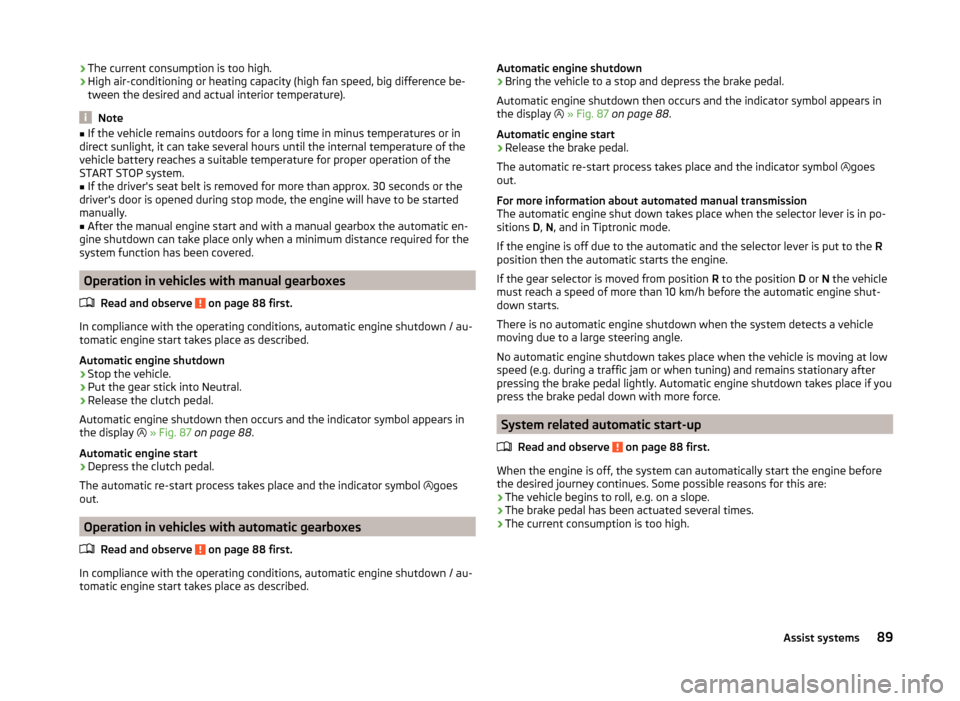
ŌĆ║The current consumption is too high.
ŌĆ║ High air-conditioning or heating capacity (high fan speed, big difference be-
tween the desired and actual interior temperature).
Note
Ō¢Ā If the vehicle remains outdoors for a long time in minus temperatures or in
direct sunlight, it can take several hours until the internal temperature of the
vehicle battery reaches a suitable temperature for proper operation of the
START STOP system.Ō¢Ā
If the driver's seat belt is removed for more than approx. 30 seconds or the
driver's door is opened during stop mode, the engine will have to be started
manually.
Ō¢Ā
After the manual engine start and with a manual gearbox the automatic en-
gine shutdown can take place only when a minimum distance required for the
system function has been covered.
Operation in vehicles with manual gearboxes
Read and observe
on page 88 first.
In compliance with the operating conditions, automatic engine shutdown / au-
tomatic engine start takes place as described.
Automatic engine shutdown
ŌĆ║
Stop the vehicle.
ŌĆ║
Put the gear stick into Neutral.
ŌĆ║
Release the clutch pedal.
Automatic engine shutdown then occurs and the indicator symbol appears in
the display ’ā”
┬╗ Fig. 87 on page 88 .
Automatic engine start
ŌĆ║
Depress the clutch pedal.
The automatic re-start process takes place and the indicator symbol ’ā”goes
out.
Operation in vehicles with automatic gearboxes
Read and observe
on page 88 first.
In compliance with the operating conditions, automatic engine shutdown / au-
tomatic engine start takes place as described.
’āż’āżAutomatic engine shutdownŌĆ║Bring the vehicle to a stop and depress the brake pedal.
Automatic engine shutdown then occurs and the indicator symbol appears in
the display ’ā”
┬╗ Fig. 87 on page 88 .
Automatic engine startŌĆ║
Release the brake pedal.
The automatic re-start process takes place and the indicator symbol ’ā”
goes
out.
For more information about automated manual transmission
The automatic engine shut down takes place when the selector lever is in po-
sitions D, N , and in Tiptronic mode.
If the engine is off due to the automatic and the selector lever is put to the R
position then the automatic starts the engine.
If the gear selector is moved from position R to the position D or N the vehicle
must reach a speed of more than 10 km/h before the automatic engine shut-
down starts.
There is no automatic engine shutdown when the system detects a vehicle
moving due to a large steering angle.
No automatic engine shutdown takes place when the vehicle is moving at low
speed (e.g. during a traffic jam or when tuning) and remains stationary after
pressing the brake pedal lightly. Automatic engine shutdown takes place if you
press the brake pedal down with more force.
System related automatic start-up
Read and observe
on page 88 first.
When the engine is off, the system can automatically start the engine before
the desired journey continues. Some possible reasons for this are:
ŌĆ║ The vehicle begins to roll, e.g. on a slope.
ŌĆ║ The brake pedal has been actuated several times.
ŌĆ║ The current consumption is too high.
’āż89Assist systems
Page 93 of 164
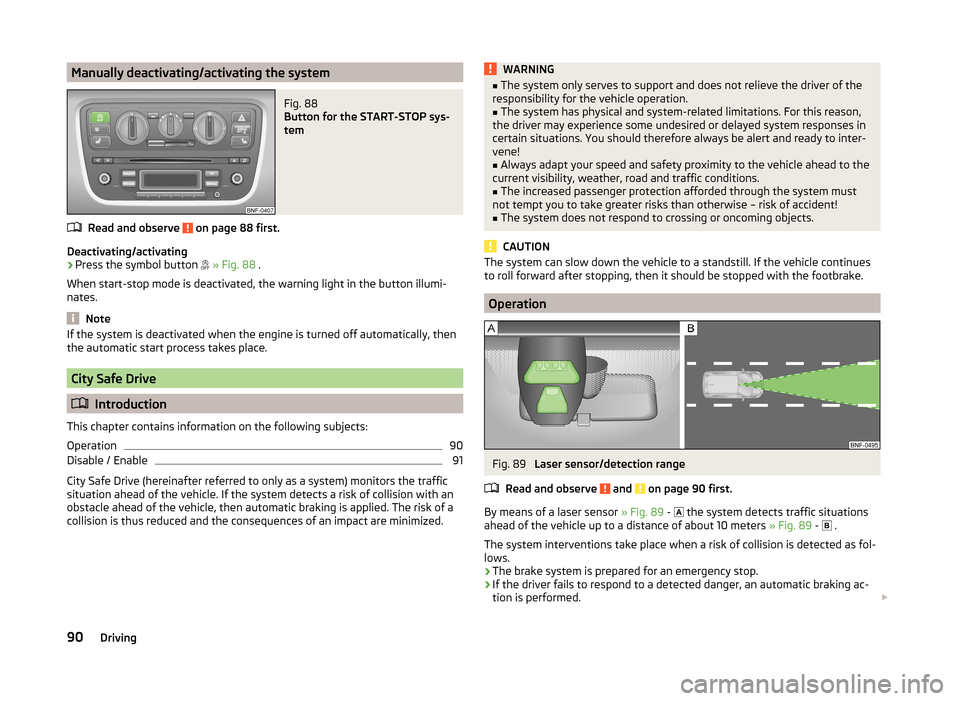
Manually deactivating/activating the systemFig. 88
Button for the START-STOP sys-
tem
Read and observe on page 88 first.
Deactivating/activating
ŌĆ║
Press the symbol button ’ā¦
┬╗ Fig. 88 .
When start-stop mode is deactivated, the warning light in the button illumi-
nates.
Note
If the system is deactivated when the engine is turned off automatically, then
the automatic start process takes place.
City Safe Drive
’āż Introduction
This chapter contains information on the following subjects:
Operation
90
Disable / Enable
91
City Safe Drive (hereinafter referred to only as a system) monitors the traffic
situation ahead of the vehicle. If the system detects a risk of collision with an
obstacle ahead of the vehicle, then automatic braking is applied. The risk of a
collision is thus reduced and the consequences of an impact are minimized.
’āżWARNINGŌ¢Ā The system only serves to support and does not relieve the driver of the
responsibility for the vehicle operation.Ō¢Ā
The system has physical and system-related limitations. For this reason,
the driver may experience some undesired or delayed system responses in
certain situations. You should therefore always be alert and ready to inter-
vene!
Ō¢Ā
Always adapt your speed and safety proximity to the vehicle ahead to the
current visibility, weather, road and traffic conditions.
Ō¢Ā
The increased passenger protection afforded through the system must
not tempt you to take greater risks than otherwise ŌĆō risk of accident!
Ō¢Ā
The system does not respond to crossing or oncoming objects.
CAUTION
The system can slow down the vehicle to a standstill. If the vehicle continues
to roll forward after stopping, then it should be stopped with the footbrake.
Operation
Fig. 89
Laser sensor/detection range
Read and observe
and on page 90 first.
By means of a laser sensor ┬╗ Fig. 89 - ’āł
the system detects traffic situations
ahead of the vehicle up to a distance of about 10 meters ┬╗ Fig. 89 - ’āē
.
The system interventions take place when a risk of collision is detected as fol- lows.
ŌĆ║ The brake system is prepared for an emergency stop.
ŌĆ║ If the driver fails to respond to a detected danger, an automatic braking ac-
tion is performed. ’éŻ
’āż90Driving
Page 94 of 164
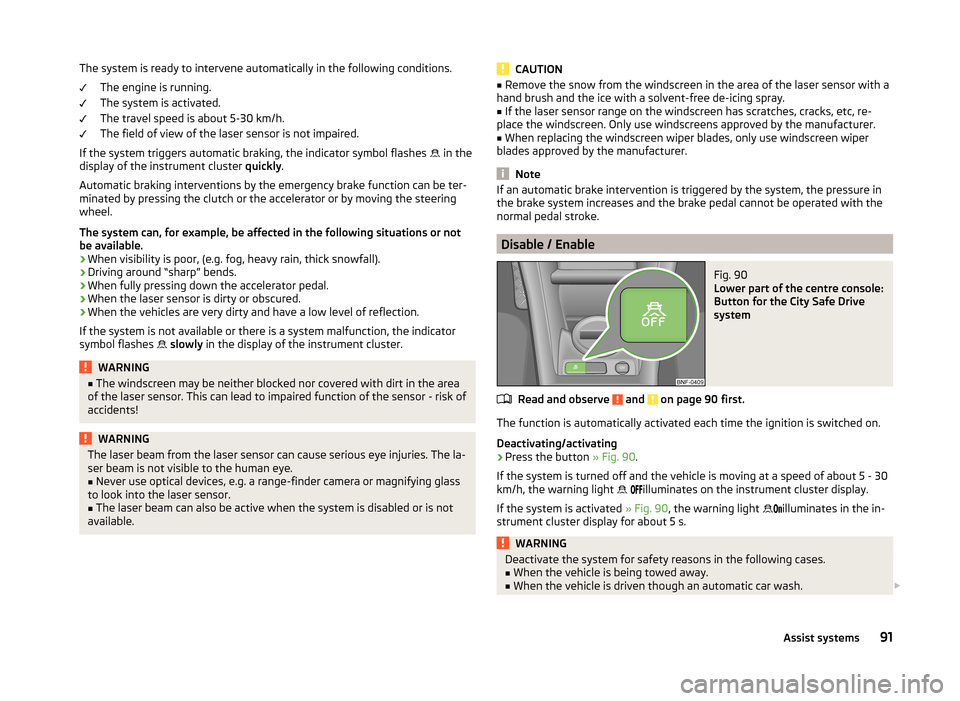
The system is ready to intervene automatically in the following conditions.The engine is running.
The system is activated.
The travel speed is about 5-30 km/h.
The field of view of the laser sensor is not impaired.
If the system triggers automatic braking, the indicator symbol flashes ’āĮ
in the
display of the instrument cluster quickly.
Automatic braking interventions by the emergency brake function can be ter-
minated by pressing the clutch or the accelerator or by moving the steering
wheel.
The system can, for example, be affected in the following situations or not
be available.
ŌĆ║ When visibility is poor, (e.g. fog, heavy rain, thick snowfall).
ŌĆ║ Driving around ŌĆ£sharpŌĆØ bends.
ŌĆ║ When fully pressing down the accelerator pedal.
ŌĆ║ When the laser sensor is dirty or obscured.
ŌĆ║ When the vehicles are very dirty and have a low level of reflection.
If the system is not available or there is a system malfunction, the indicator
symbol flashes ’āĮ
slowly in the display of the instrument cluster.WARNINGŌ¢Ā
The windscreen may be neither blocked nor covered with dirt in the area
of the laser sensor. This can lead to impaired function of the sensor - risk of
accidents!WARNINGThe laser beam from the laser sensor can cause serious eye injuries. The la-
ser beam is not visible to the human eye.Ō¢Ā
Never use optical devices, e.g. a range-finder camera or magnifying glass
to look into the laser sensor.
Ō¢Ā
The laser beam can also be active when the system is disabled or is not
available.
’éź’éź’éź’éźCAUTIONŌ¢Ā Remove the snow from the windscreen in the area of the laser sensor with a
hand brush and the ice with a solvent-free de-icing spray.Ō¢Ā
If the laser sensor range on the windscreen has scratches, cracks, etc, re-
place the windscreen. Only use windscreens approved by the manufacturer.
Ō¢Ā
When replacing the windscreen wiper blades, only use windscreen wiper
blades approved by the manufacturer.
Note
If an automatic brake intervention is triggered by the system, the pressure in
the brake system increases and the brake pedal cannot be operated with the
normal pedal stroke.
Disable / Enable
Fig. 90
Lower part of the centre console:
Button for the City Safe Drive
system
Read and observe and on page 90 first.
The function is automatically activated each time the ignition is switched on.
Deactivating/activating
ŌĆ║
Press the button ┬╗ Fig. 90.
If the system is turned off and the vehicle is moving at a speed of about 5 - 30
km/h, the warning light ’āĮ
’üÅ’üå’üå
illuminates on the instrument cluster display.
If the system is activated ┬╗ Fig. 90, the warning light ’āĮ
’üÅ
’é®illuminates in the in-
strument cluster display for about 5 s.
WARNINGDeactivate the system for safety reasons in the following cases.Ō¢ĀWhen the vehicle is being towed away.Ō¢Ā
When the vehicle is driven though an automatic car wash. ’éŻ
’āż91Assist systems
Page 95 of 164
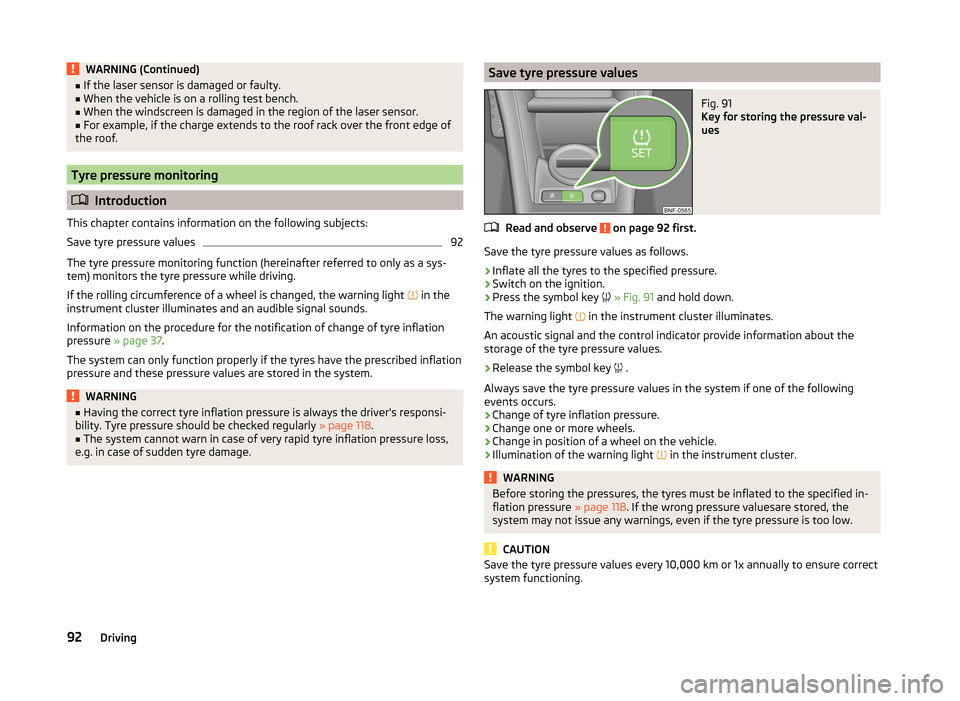
WARNING (Continued)Ō¢ĀIf the laser sensor is damaged or faulty.Ō¢ĀWhen the vehicle is on a rolling test bench.Ō¢Ā
When the windscreen is damaged in the region of the laser sensor.
Ō¢Ā
For example, if the charge extends to the roof rack over the front edge of
the roof.
Tyre pressure monitoring
’āż Introduction
This chapter contains information on the following subjects:
Save tyre pressure values
92
The tyre pressure monitoring function (hereinafter referred to only as a sys-
tem) monitors the tyre pressure while driving.
If the rolling circumference of a wheel is changed, the warning light ’āć in the
instrument cluster illuminates and an audible signal sounds.
Information on the procedure for the notification of change of tyre inflation
pressure ┬╗ page 37 .
The system can only function properly if the tyres have the prescribed inflation
pressure and these pressure values are stored in the system.
WARNINGŌ¢Ā Having the correct tyre inflation pressure is always the driver's responsi-
bility. Tyre pressure should be checked regularly ┬╗ page 118.Ō¢Ā
The system cannot warn in case of very rapid tyre inflation pressure loss,
e.g. in case of sudden tyre damage.
Save tyre pressure valuesFig. 91
Key for storing the pressure val-
ues
Read and observe on page 92 first.
Save the tyre pressure values as follows.
ŌĆ║
Inflate all the tyres to the specified pressure.
ŌĆ║
Switch on the ignition.
ŌĆ║
Press the symbol key ’āĄ
┬╗ Fig. 91 and hold down.
The warning light ’āć in the instrument cluster illuminates.
An acoustic signal and the control indicator provide information about the
storage of the tyre pressure values.
ŌĆ║
Release the symbol key ’āĄ .
Always save the tyre pressure values in the system if one of the following
events occurs.
ŌĆ║ Change of tyre inflation pressure.
ŌĆ║ Change one or more wheels.
ŌĆ║ Change in position of a wheel on the vehicle.
ŌĆ║ Illumination of the warning light
’āć in the instrument cluster.
WARNINGBefore storing the pressures, the tyres must be inflated to the specified in-
flation pressure ┬╗ page 118. If the wrong pressure valuesare stored, the
system may not issue any warnings, even if the tyre pressure is too low.
CAUTION
Save the tyre pressure values every 10,000 km or 1x annually to ensure correct
system functioning.’āż92Driving
Page 96 of 164
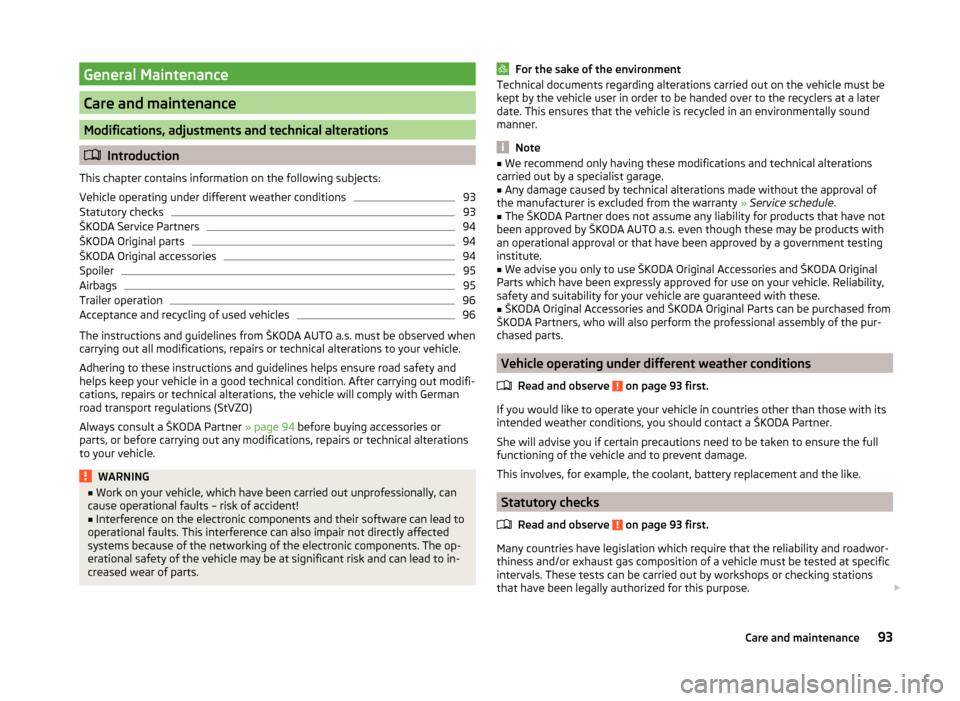
General Maintenance
Care and maintenance
Modifications, adjustments and technical alterations
’āżIntroduction
This chapter contains information on the following subjects:
Vehicle operating under different weather conditions
93
Statutory checks
93
┼ĀKODA Service Partners
94
┼ĀKODA Original parts
94
┼ĀKODA Original accessories
94
Spoiler
95
Airbags
95
Trailer operation
96
Acceptance and recycling of used vehicles
96
The instructions and guidelines from ┼ĀKODA AUTO a.s. must be observed when
carrying out all modifications, repairs or technical alterations to your vehicle.
Adhering to these instructions and guidelines helps ensure road safety and
helps keep your vehicle in a good technical condition. After carrying out modifi-
cations, repairs or technical alterations, the vehicle will comply with German
road transport regulations (StVZO)
Always consult a ┼ĀKODA Partner ┬╗ page 94 before buying accessories or
parts, or before carrying out any modifications, repairs or technical alterations to your vehicle.
WARNINGŌ¢Ā Work on your vehicle, which have been carried out unprofessionally, can
cause operational faults ŌĆō risk of accident!Ō¢Ā
Interference on the electronic components and their software can lead to
operational faults. This interference can also impair not directly affected
systems because of the networking of the electronic components. The op-
erational safety of the vehicle may be at significant risk and can lead to in-
creased wear of parts.
For the sake of the environmentTechnical documents regarding alterations carried out on the vehicle must be
kept by the vehicle user in order to be handed over to the recyclers at a later
date. This ensures that the vehicle is recycled in an environmentally sound
manner.
Note
Ō¢Ā We recommend only having these modifications and technical alterations
carried out by a specialist garage.Ō¢Ā
Any damage caused by technical alterations made without the approval of
the manufacturer is excluded from the warranty ┬╗ Service schedule .
Ō¢Ā
The ┼ĀKODA Partner does not assume any liability for products that have not
been approved by ┼ĀKODA AUTO a.s. even though these may be products with
an operational approval or that have been approved by a government testing
institute.
Ō¢Ā
We advise you only to use ┼ĀKODA Original Accessories and ┼ĀKODA Original
Parts which have been expressly approved for use on your vehicle. Reliability,
safety and suitability for your vehicle are guaranteed with these.
Ō¢Ā
┼ĀKODA Original Accessories and ┼ĀKODA Original Parts can be purchased from
┼ĀKODA Partners, who will also perform the professional assembly of the pur-
chased parts.
Vehicle operating under different weather conditions
Read and observe
on page 93 first.
If you would like to operate your vehicle in countries other than those with itsintended weather conditions, you should contact a ┼ĀKODA Partner.
She will advise you if certain precautions need to be taken to ensure the full
functioning of the vehicle and to prevent damage.
This involves, for example, the coolant, battery replacement and the like.
Statutory checks
Read and observe
on page 93 first.
Many countries have legislation which require that the reliability and roadwor-thiness and/or exhaust gas composition of a vehicle must be tested at specific
intervals. These tests can be carried out by workshops or checking stations
that have been legally authorized for this purpose. ’éŻ
’āż’āż93Care and maintenance
Page 97 of 164
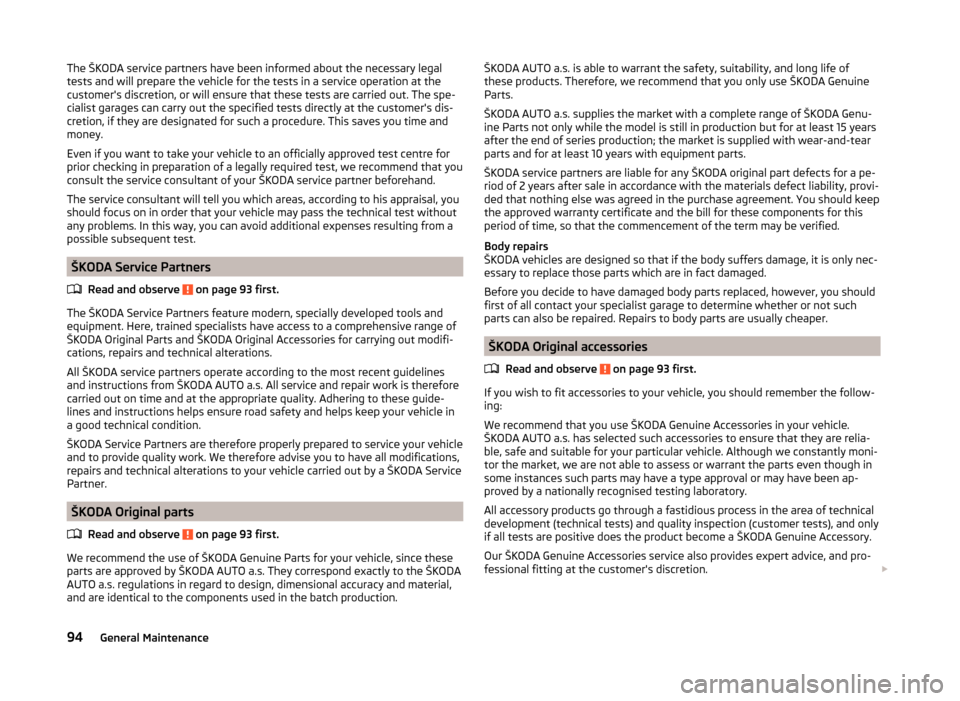
The ┼ĀKODA service partners have been informed about the necessary legal
tests and will prepare the vehicle for the tests in a service operation at the
customer's discretion, or will ensure that these tests are carried out. The spe-
cialist garages can carry out the specified tests directly at the customer's dis-
cretion, if they are designated for such a procedure. This saves you time and
money.
Even if you want to take your vehicle to an officially approved test centre for
prior checking in preparation of a legally required test, we recommend that you
consult the service consultant of your ┼ĀKODA service partner beforehand.
The service consultant will tell you which areas, according to his appraisal, you
should focus on in order that your vehicle may pass the technical test without
any problems. In this way, you can avoid additional expenses resulting from a
possible subsequent test.
┼ĀKODA Service Partners
Read and observe
on page 93 first.
The ┼ĀKODA Service Partners feature modern, specially developed tools and
equipment. Here, trained specialists have access to a comprehensive range of
┼ĀKODA Original Parts and ┼ĀKODA Original Accessories for carrying out modifi-
cations, repairs and technical alterations.
All ┼ĀKODA service partners operate according to the most recent guidelines
and instructions from ┼ĀKODA AUTO a.s. All service and repair work is therefore
carried out on time and at the appropriate quality. Adhering to these guide-
lines and instructions helps ensure road safety and helps keep your vehicle in
a good technical condition.
┼ĀKODA Service Partners are therefore properly prepared to service your vehicle
and to provide quality work. We therefore advise you to have all modifications,
repairs and technical alterations to your vehicle carried out by a ┼ĀKODA Service
Partner.
┼ĀKODA Original parts
Read and observe
on page 93 first.
We recommend the use of ┼ĀKODA Genuine Parts for your vehicle, since these
parts are approved by ┼ĀKODA AUTO a.s. They correspond exactly to the ┼ĀKODA
AUTO a.s. regulations in regard to design, dimensional accuracy and material,
and are identical to the components used in the batch production.
’āż’āż┼ĀKODA AUTO a.s. is able to warrant the safety, suitability, and long life of
these products. Therefore, we recommend that you only use ┼ĀKODA Genuine
Parts.
┼ĀKODA AUTO a.s. supplies the market with a complete range of ┼ĀKODA Genu-
ine Parts not only while the model is still in production but for at least 15 years
after the end of series production; the market is supplied with wear-and-tear
parts and for at least 10 years with equipment parts.
┼ĀKODA service partners are liable for any ┼ĀKODA original part defects for a pe- riod of 2 years after sale in accordance with the materials defect liability, provi-
ded that nothing else was agreed in the purchase agreement. You should keep
the approved warranty certificate and the bill for these components for this
period of time, so that the commencement of the term may be verified.
Body repairs
┼ĀKODA vehicles are designed so that if the body suffers damage, it is only nec-
essary to replace those parts which are in fact damaged.
Before you decide to have damaged body parts replaced, however, you should first of all contact your specialist garage to determine whether or not such
parts can also be repaired. Repairs to body parts are usually cheaper.
┼ĀKODA Original accessories
Read and observe
on page 93 first.
If you wish to fit accessories to your vehicle, you should remember the follow-ing:
We recommend that you use ┼ĀKODA Genuine Accessories in your vehicle.
┼ĀKODA AUTO a.s. has selected such accessories to ensure that they are relia-
ble, safe and suitable for your particular vehicle. Although we constantly moni-
tor the market, we are not able to assess or warrant the parts even though in
some instances such parts may have a type approval or may have been ap-
proved by a nationally recognised testing laboratory.
All accessory products go through a fastidious process in the area of technical
development (technical tests) and quality inspection (customer tests), and only
if all tests are positive does the product become a ┼ĀKODA Genuine Accessory.
Our ┼ĀKODA Genuine Accessories service also provides expert advice, and pro-
fessional fitting at the customer's discretion. ’éŻ
’āż94General Maintenance
Page 98 of 164
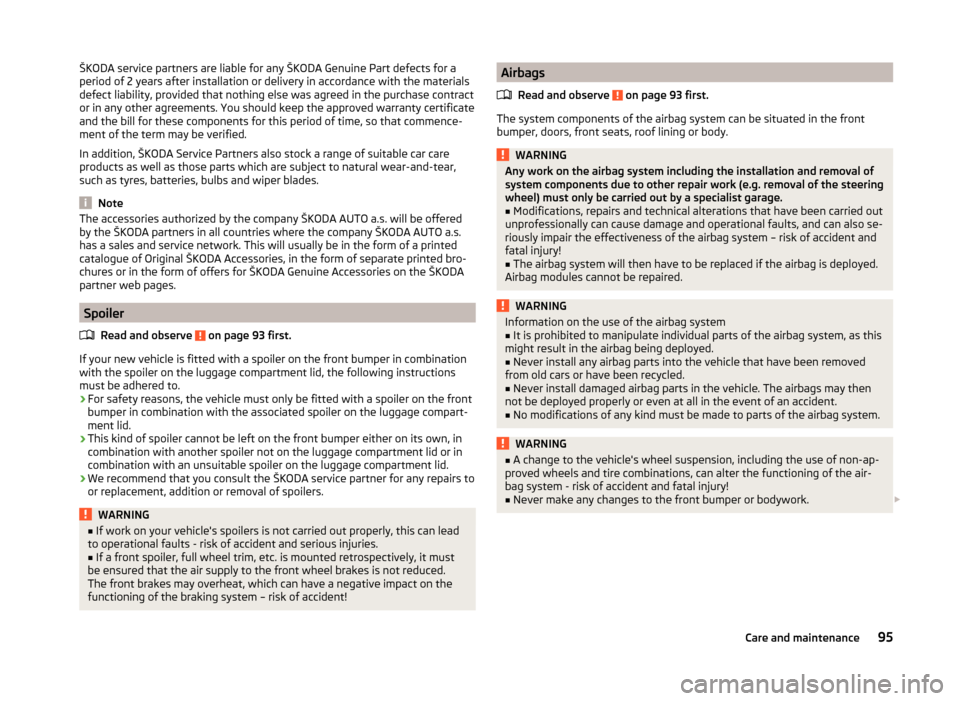
┼ĀKODA service partners are liable for any ┼ĀKODA Genuine Part defects for aperiod of 2 years after installation or delivery in accordance with the materials
defect liability, provided that nothing else was agreed in the purchase contract
or in any other agreements. You should keep the approved warranty certificate
and the bill for these components for this period of time, so that commence-
ment of the term may be verified.
In addition, ┼ĀKODA Service Partners also stock a range of suitable car care
products as well as those parts which are subject to natural wear-and-tear,
such as tyres, batteries, bulbs and wiper blades.
Note
The accessories authorized by the company ┼ĀKODA AUTO a.s. will be offered
by the ┼ĀKODA partners in all countries where the company ┼ĀKODA AUTO a.s.
has a sales and service network. This will usually be in the form of a printed
catalogue of Original ┼ĀKODA Accessories, in the form of separate printed bro-
chures or in the form of offers for ┼ĀKODA Genuine Accessories on the ┼ĀKODA
partner web pages.
Spoiler
Read and observe
on page 93 first.
If your new vehicle is fitted with a spoiler on the front bumper in combination
with the spoiler on the luggage compartment lid, the following instructions
must be adhered to.
ŌĆ║ For safety reasons, the vehicle must only be fitted with a spoiler on the front
bumper in combination with the associated spoiler on the luggage compart-
ment lid.
ŌĆ║ This kind of spoiler cannot be left on the front bumper either on its own, in
combination with another spoiler not on the luggage compartment lid or in
combination with an unsuitable spoiler on the luggage compartment lid.
ŌĆ║ We recommend that you consult the ┼ĀKODA service partner for any repairs to
or replacement, addition or removal of spoilers.
WARNINGŌ¢Ā If work on your vehicle's spoilers is not carried out properly, this can lead
to operational faults - risk of accident and serious injuries.Ō¢Ā
If a front spoiler, full wheel trim, etc. is mounted retrospectively, it must
be ensured that the air supply to the front wheel brakes is not reduced.
The front brakes may overheat, which can have a negative impact on the
functioning of the braking system ŌĆō risk of accident!
’āżAirbags
Read and observe
on page 93 first.
The system components of the airbag system can be situated in the front
bumper, doors, front seats, roof lining or body.
WARNINGAny work on the airbag system including the installation and removal of
system components due to other repair work (e.g. removal of the steering
wheel) must only be carried out by a specialist garage.Ō¢Ā
Modifications, repairs and technical alterations that have been carried out
unprofessionally can cause damage and operational faults, and can also se-
riously impair the effectiveness of the airbag system ŌĆō risk of accident and
fatal injury!
Ō¢Ā
The airbag system will then have to be replaced if the airbag is deployed.
Airbag modules cannot be repaired.
WARNINGInformation on the use of the airbag systemŌ¢ĀIt is prohibited to manipulate individual parts of the airbag system, as this
might result in the airbag being deployed.Ō¢Ā
Never install any airbag parts into the vehicle that have been removed
from old cars or have been recycled.
Ō¢Ā
Never install damaged airbag parts in the vehicle. The airbags may then
not be deployed properly or even at all in the event of an accident.
Ō¢Ā
No modifications of any kind must be made to parts of the airbag system.
WARNINGŌ¢Ā A change to the vehicle's wheel suspension, including the use of non-ap-
proved wheels and tire combinations, can alter the functioning of the air-
bag system - risk of accident and fatal injury!Ō¢Ā
Never make any changes to the front bumper or bodywork. ’éŻ
’āż95Care and maintenance
Page 99 of 164
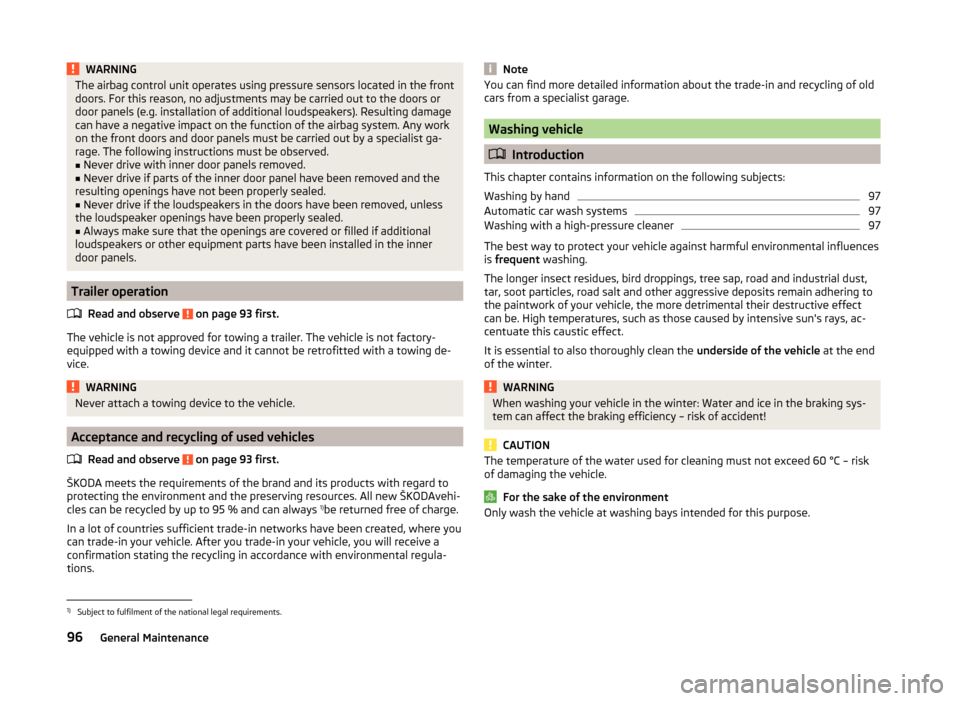
WARNINGThe airbag control unit operates using pressure sensors located in the front
doors. For this reason, no adjustments may be carried out to the doors or
door panels (e.g. installation of additional loudspeakers). Resulting damage
can have a negative impact on the function of the airbag system. Any work
on the front doors and door panels must be carried out by a specialist ga-
rage. The following instructions must be observed.Ō¢Ā
Never drive with inner door panels removed.
Ō¢Ā
Never drive if parts of the inner door panel have been removed and the
resulting openings have not been properly sealed.
Ō¢Ā
Never drive if the loudspeakers in the doors have been removed, unless
the loudspeaker openings have been properly sealed.
Ō¢Ā
Always make sure that the openings are covered or filled if additional
loudspeakers or other equipment parts have been installed in the inner
door panels.
Trailer operation
Read and observe
on page 93 first.
The vehicle is not approved for towing a trailer. The vehicle is not factory-
equipped with a towing device and it cannot be retrofitted with a towing de-
vice.
WARNINGNever attach a towing device to the vehicle.
Acceptance and recycling of used vehicles
Read and observe
on page 93 first.
┼ĀKODA meets the requirements of the brand and its products with regard to
protecting the environment and the preserving resources. All new ┼ĀKODAvehi-
cles can be recycled by up to 95 % and can always 1)
be returned free of charge.
In a lot of countries sufficient trade-in networks have been created, where you
can trade-in your vehicle. After you trade-in your vehicle, you will receive a
confirmation stating the recycling in accordance with environmental regula-
tions.
’āż’āżNoteYou can find more detailed information about the trade-in and recycling of old
cars from a specialist garage.
Washing vehicle
’āż Introduction
This chapter contains information on the following subjects:
Washing by hand
97
Automatic car wash systems
97
Washing with a high-pressure cleaner
97
The best way to protect your vehicle against harmful environmental influences
is frequent washing.
The longer insect residues, bird droppings, tree sap, road and industrial dust,
tar, soot particles, road salt and other aggressive deposits remain adhering to
the paintwork of your vehicle, the more detrimental their destructive effect
can be. High temperatures, such as those caused by intensive sun's rays, ac-
centuate this caustic effect.
It is essential to also thoroughly clean the underside of the vehicle at the end
of the winter.
WARNINGWhen washing your vehicle in the winter: Water and ice in the braking sys-
tem can affect the braking efficiency ŌĆō risk of accident!
CAUTION
The temperature of the water used for cleaning must not exceed 60 ┬░C ŌĆō risk
of damaging the vehicle.
For the sake of the environment
Only wash the vehicle at washing bays intended for this purpose.1)
Subject to fulfilment of the national legal requirements.
96General Maintenance
Page 100 of 164
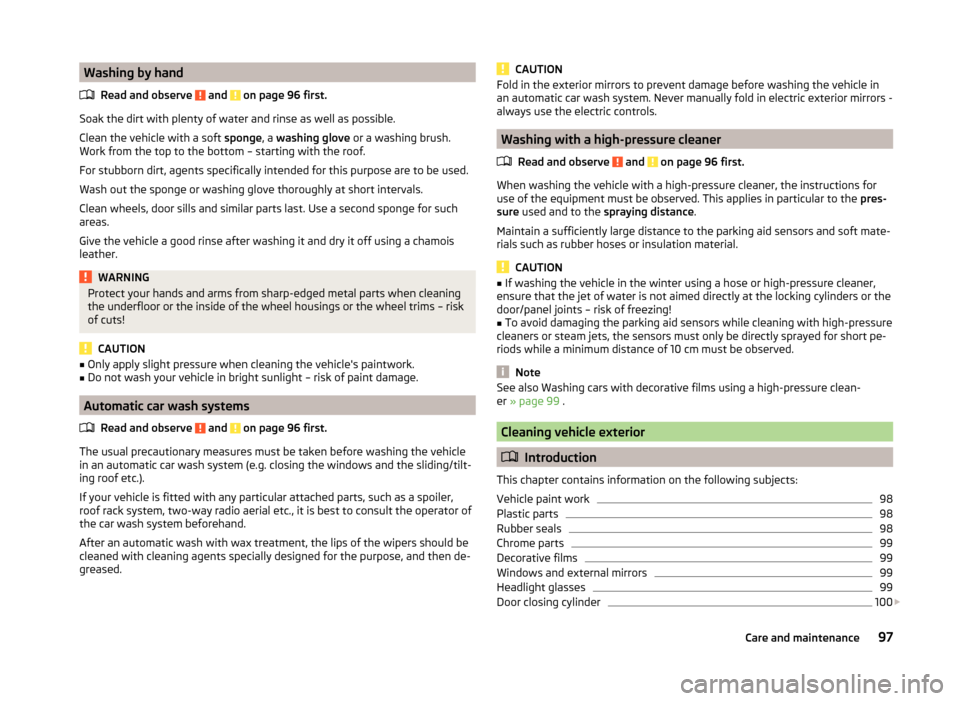
Washing by handRead and observe
and on page 96 first.
Soak the dirt with plenty of water and rinse as well as possible.
Clean the vehicle with a soft sponge, a washing glove or a washing brush.
Work from the top to the bottom ŌĆō starting with the roof.
For stubborn dirt, agents specifically intended for this purpose are to be used. Wash out the sponge or washing glove thoroughly at short intervals.
Clean wheels, door sills and similar parts last. Use a second sponge for such areas.
Give the vehicle a good rinse after washing it and dry it off using a chamois
leather.
WARNINGProtect your hands and arms from sharp-edged metal parts when cleaning
the underfloor or the inside of the wheel housings or the wheel trims ŌĆō risk
of cuts!
CAUTION
Ō¢Ā Only apply slight pressure when cleaning the vehicle's paintwork.Ō¢ĀDo not wash your vehicle in bright sunlight ŌĆō risk of paint damage.
Automatic car wash systems
Read and observe
and on page 96 first.
The usual precautionary measures must be taken before washing the vehicle
in an automatic car wash system (e.g. closing the windows and the sliding/tilt-
ing roof etc.).
If your vehicle is fitted with any particular attached parts, such as a spoiler,
roof rack system, two-way radio aerial etc., it is best to consult the operator of
the car wash system beforehand.
After an automatic wash with wax treatment, the lips of the wipers should be
cleaned with cleaning agents specially designed for the purpose, and then de-
greased.
’āż’āżCAUTIONFold in the exterior mirrors to prevent damage before washing the vehicle in
an automatic car wash system. Never manually fold in electric exterior mirrors -
always use the electric controls.
Washing with a high-pressure cleaner
Read and observe
and on page 96 first.
When washing the vehicle with a high-pressure cleaner, the instructions foruse of the equipment must be observed. This applies in particular to the pres-
sure used and to the spraying distance .
Maintain a sufficiently large distance to the parking aid sensors and soft mate-
rials such as rubber hoses or insulation material.
CAUTION
Ō¢Ā If washing the vehicle in the winter using a hose or high-pressure cleaner,
ensure that the jet of water is not aimed directly at the locking cylinders or the
door/panel joints ŌĆō risk of freezing!Ō¢Ā
To avoid damaging the parking aid sensors while cleaning with high-pressure
cleaners or steam jets, the sensors must only be directly sprayed for short pe-
riods while a minimum distance of 10 cm must be observed.
Note
See also Washing cars with decorative films using a high-pressure clean-
er ┬╗ page 99 .
Cleaning vehicle exterior
’āż
Introduction
This chapter contains information on the following subjects:
Vehicle paint work
98
Plastic parts
98
Rubber seals
98
Chrome parts
99
Decorative films
99
Windows and external mirrors
99
Headlight glasses
99
Door closing cylinder
100
’éŻ
’āż97Care and maintenance